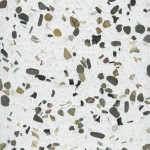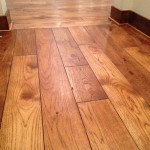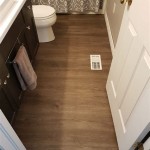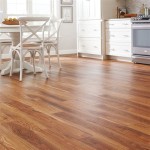How to Determine the Quality of Laminate Flooring
Laminate flooring has become a popular alternative to hardwood due to its affordability, durability, and ease of installation. However, the quality of laminate flooring varies significantly across different brands and product lines. Understanding the key indicators of quality is crucial to ensuring customer satisfaction and longevity of the flooring. This article outlines the factors that contribute to high-quality laminate flooring and provides guidance on how to assess its overall quality before making a purchase.
Laminate flooring consists of several layers, each contributing to its overall performance. The surface layer, known as the wear layer, is a transparent coating that protects the decorative layer beneath. The decorative layer is a photographic image that replicates wood, stone, or other materials. Underneath the decorative layer is the core board, typically made of high-density fiberboard (HDF) or medium-density fiberboard (MDF). The bottom layer, or backing layer, provides stability and helps prevent moisture from seeping into the core.
The quality of each of these layers directly impacts the durability, appearance, and longevity of the flooring. While a visual inspection can offer some clues, delving deeper into the specifications and certifications is necessary for a comprehensive assessment.
Assessing the Wear Layer and Abrasion Resistance
The wear layer is the first line of defense against scratches, stains, and fading. A thicker wear layer generally indicates higher durability and resistance to wear and tear. The industry standard for measuring wear layer thickness is the AC rating, which stands for Abrasion Class. This rating is determined through a standardized testing process that simulates foot traffic and wear. The AC rating scale ranges from AC1 to AC5, with higher numbers indicating greater resistance to abrasion.
AC1 rated laminate is suitable for light residential use, such as bedrooms or closets. AC2 rated laminate is appropriate for moderate residential use, such as living rooms or dining rooms. AC3 rated laminate is designed for heavy residential use and light commercial use, such as hallways, kitchens, or small offices. AC4 rated laminate is suitable for general commercial use, such as offices, boutiques, or cafes. AC5 rated laminate is designed for heavy commercial use, such as department stores or public buildings.
When selecting laminate flooring, consider the intended use of the room and choose an AC rating that is appropriate for the expected level of foot traffic. For high-traffic areas, such as hallways or entryways, selecting an AC4 or AC5 rated laminate is recommended to ensure long-term durability and prevent premature wear.
Beyond the AC rating, the composition of the wear layer also plays a role in its quality. Some wear layers are treated with special coatings to enhance stain resistance and UV protection. These coatings can significantly improve the longevity and appearance of the flooring, particularly in areas exposed to direct sunlight or spills.
To assess the wear layer, inquire about the AC rating and any additional coatings applied to the surface. Examine samples of the flooring for any signs of scratches or wear after being subjected to light abrasion. This can provide a preliminary indication of the wear layer's durability.
Evaluating the Core Board and Moisture Resistance
The core board provides the structural foundation for the laminate flooring. Its density and composition directly impact the flooring's resistance to moisture and impact. HDF core boards are generally denser and more resistant to moisture than MDF core boards. Higher density translates to greater stability and less susceptibility to swelling or warping when exposed to humidity or spills.
Moisture resistance is a critical factor, especially in areas prone to spills or high humidity, such as kitchens, bathrooms, or basements. Laminate flooring with a high-quality core board and a moisture-resistant backing layer can withstand occasional spills and humidity fluctuations without significant damage. However, it is important to note that laminate flooring is not waterproof and prolonged exposure to standing water can still cause damage.
Several factors influence the moisture resistance of the core board. The type of wood fibers used, the resin content, and the manufacturing process all contribute to its ability to repel water. Some manufacturers treat the core board with special sealants to further enhance its moisture resistance.
When evaluating the core board, inquire about its density and composition. Look for laminate flooring with an HDF core board and a moisture-resistant backing layer. Check for any certifications or warranties related to moisture resistance. Some manufacturers offer warranties specifically covering damage caused by moisture exposure.
It’s also important to consider the thickness of the core board. A thicker core board generally provides greater stability and impact resistance, reducing the likelihood of dents or cracks from heavy furniture or dropped objects. A thicker core board can also contribute to better sound insulation.
Examining the Decorative Layer and Overall Appearance
The decorative layer significantly impacts the aesthetic appeal of the laminate flooring. High-quality laminate flooring features a realistic and detailed image that closely resembles the natural material it is designed to replicate. Look for flooring with a high-resolution image and a textured surface that mimics the grain and texture of wood or stone.
The quality of the decorative layer also affects its resistance to fading and discoloration. UV protection is essential for preserving the original color and appearance of the flooring, especially in areas exposed to direct sunlight. Some manufacturers use fade-resistant inks and coatings to enhance the decorative layer's durability.
The edges of the laminate planks or tiles are also important for overall appearance. Look for flooring with tightly fitting edges that create a seamless and uniform surface. Beveled edges can add depth and dimension to the flooring, while square edges provide a clean and modern look.
When examining the decorative layer, carefully inspect the image for clarity, detail, and realism. Compare the flooring to samples of the natural material it is designed to replicate. Look for any signs of fading or discoloration after exposure to sunlight. Check the edges of the planks or tiles for any gaps or imperfections.
Furthermore, consider the pattern repeat. A higher-quality laminate will have a longer pattern repeat, making the flooring look more natural and less repetitive. A short pattern repeat can make the flooring look artificial and less visually appealing.
Considering Installation System and Locking Mechanism
The installation system is another important factor to consider when evaluating laminate flooring quality. Laminate flooring typically uses a click-lock system, which allows the planks or tiles to be easily snapped together without the need for glue or nails. The quality of the locking mechanism directly impacts the ease of installation and the long-term stability of the flooring.
A high-quality locking mechanism should be strong and durable, creating a tight and secure connection between the planks or tiles. This prevents gaps or movement over time, which can lead to uneven surfaces and increased wear. Look for flooring with a locking mechanism that has been tested and certified for strength and durability.
Some locking mechanisms are designed for easier installation, featuring features such as drop-lock or angle-lock systems. These systems simplify the process of connecting the planks or tiles, reducing the risk of damage or misalignment. Consider the ease of installation when selecting laminate flooring, especially if you plan to install it yourself.
When evaluating the locking mechanism, try snapping together a few samples of the flooring to test its ease of use and strength. Look for a system that creates a tight and secure connection without requiring excessive force. Check for any gaps or movement after the planks or tiles are connected.
Poorly constructed locking systems will be difficult to engage and may break during installation or subsequent use. This can lead to costly repairs and reduced satisfaction with the flooring.
Reviewing Certifications and Warranties
Certifications and warranties provide additional assurance of the quality and performance of laminate flooring. Look for flooring that has been certified by reputable organizations, such as the FloorScore or Greenguard Environmental Institute. These certifications indicate that the flooring has been tested for low emissions of volatile organic compounds (VOCs), which can contribute to indoor air pollution.
Warranties offer protection against defects in materials or workmanship. Read the warranty carefully to understand the terms and conditions, including the length of the warranty period and the specific types of damage covered. A longer warranty period generally indicates greater confidence in the product's quality and durability.
Different types of warranties are available for laminate flooring, including wear warranties, stain warranties, and fade warranties. Wear warranties cover damage caused by normal foot traffic, while stain warranties cover damage caused by spills or stains. Fade warranties cover damage caused by exposure to sunlight.
When reviewing certifications and warranties, look for flooring that has been certified for low VOC emissions and offers comprehensive coverage against various types of damage. Compare the warranties offered by different manufacturers to determine which provides the best protection for your investment.
In addition to these factors, consider consulting with experienced flooring professionals or reading online reviews to gather more information about the quality and performance of specific laminate flooring brands and products. Gathering diverse perspectives can help you make an informed decision and choose the best laminate flooring for your needs.

How To Tell If Your Floor Is Hardwood Or Vinyl Garrison Collection

Vinyl Plank Vs Laminate Flooring Which Is Right For You Onflooring

How Do You Know It S Time To Replace Your Laminate Flooring Southside Building Center

Laminate Vs Lvp Choose The Ideal Floor Today Reallyfloors America S Est Hardwood Flooring

Luxury Vinyl Plank Vs Laminate What S The Difference

Laminate Vs Vinyl Flooring Costs Pros Cons Differences 2025

How To Spot Quality Laminate Flooring A Buyer S Guide Alexandria Gainesville And Leesburg Va Floor Advisor

Engineered Hardwood Vs Laminate Flooring

Laminate Vs Vinyl Flooring A Comparative Guide

Determining The Direction To Lay Install Hardwood Laminate Or Luxury Vinyl Plank Flooring
Related Posts








